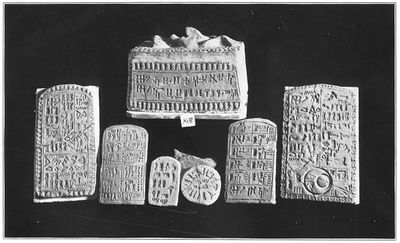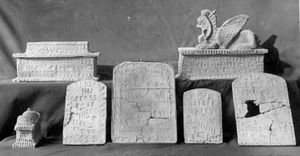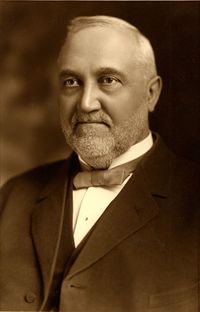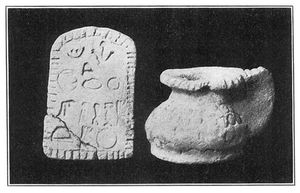Michigan Relics

By Jacob McCormick
The Michigan Relics (also known as the Soper Frauds) are a large grouping of pseudoarchaeological prehistoric artifacts "discovered" throughout the state of Michigan in the late nineteenth and early twentieth centuries. Many of the relics were inscribed with fraudulent hieroglyphs and cuneiform and were originally believed to be proof of pre-Columbian contact with the Americas. The Michigan Relics are considered, for many reasons, to be one of the most elaborate and extensive archaeological hoaxes ever perpetrated in American history.[2]
The Relics in the 1890s

The first discovery of the relics in Michigan occurred in October 1890 when James O. Scotford found a small clay cup while digging post holes in a field in Wyman, Montcalm County, Michigan. Scotford was a well-known digger and sign painter in the area of Wyman. Shortly after that initial discovery in Wyman, many other more elaborate discoveries were made in a three or four mile diameter around the village. Most of the artifacts were authenticated by the prominent locals who witnessed their discovery. Scores of "remarkable objects" were unearthed anywhere from one to four feet into the surface undulations and mounds. [4] Among the objects uncovered were small caskets, tablets, ornaments, weapons, tools, smoking pipes, and pottery vessels made of copper and baked and unbaked clay of varying colors. Within the first year of Scotford's initial discovery a syndicate was formed in Montcalm County of interested parties. The syndicate purchased many of the artifacts and attempted to exploit the finds financially for the region.[5]
First Debunked in 1891
Scotford's "Michigan Relics" were quickly debunked by academics who found problems with the discoveries. Professor F.W. Putnam, curator of the Peabody Museum of Archaeology and Ethnology at Harvard University from 1874 to 1909, was sent photographs of the discoveries. Professor Alfred Emerson, an archaeologist at Lake Forest College (who later moved to Cornell University), reviewed the "relics" in June 1891. Following his visit, Emerson wrote "The articles were bad enough in the photograph... an examination proved them to be humbugs of the first water." Emerson's evaluation of the objects was swift and decisive, the Michigan Relics were archaeological forgeries.

In 1892, Professor Francis W. Kelsey, professor of Latin and Literature at the University of Michigan, along with Professor Morris Jastrow, Jr., librarian and professor of Semitic languages at the University of Pennsylvania, joined Emerson in calling the Michigan Relics frauds. Kelsey and Jastrow primarily evaluated the linguistics on the objects, calling the relics a "horrible mixture" of jumbled ancient scripts. Both professors agreed that the finds were fraudulent and were produced by someone with no knowledge of linguistics or the ancient languages they attempted to replicate on the objects.[7] Even with no archaeological training, Kelsey concurred with Emerson's evaluation of the flaws of the objects, he outlined some specific observations in his publication on the topic:
- The hieroglyphs were stamped cuneiform characters in random order.
- The figures on some of the discoveries included lions with no tails, an omission which would not have occurred by "primative" artists.
- The clay items were dried on a machine-sawed board.
- The objects disintegrated in water, indicating that they could not have been buried in the ground for very long.[8]
Despite the Michigan Relics being thoroughly debunked by several academics across the United States, Scotford persisted in promoting the artifacts. In 1893, Walter Wyman, head archaeologist of the Chicago World's Fair, turned away Scotford's submission of a stone casket to the fair and concurred with prior assessments that the Michigan Relics were fraudulent.
The University of Michigan
In 1898, the University of Michigan was presented with the opportunity to purchase a collection of the relics for the University museum. The batch that was offered had travelled the country as an exhibit, advertised as "The Finest Collection of Pre-Historic Relics Ever Exhibited in the United States." The original price asked was one thousand dollars which was quickly lowered to one hundred dollars. The University had been involved in the matter several years prior, in 1892, when Professor Frank Kelsey evaluated the Scotford finds as archaeological forgeries. The curator of the museum declined the offer to purchase the material, which was still deemed fraudulent and denounced by academics. However, the University obliged when asked to store the collection. In an effort to keep the bogus relics off the market, the University of Michigan stored the crates for several decades with the understanding that the owner would eventually retrieve the fake artifacts - they never did.
The pieces in this collection of the Michigan Relics were different than the earlier pieces that had been found and evaluated. The clay was baked more thoroughly and the craftsmanship of the pieces was better all around. The academic assessments of the relics in the early 1890s had provided a framework for the pieces to be made more convincingly. Though the Michigan Relics were deemed fraudulent by countless academics throughout the decade, Scotford persisted in promoting and selling the pieces that he continued to uncover, seemingly endlessly, throughout the state.
The Relics in the Twentieth Century

Supporters of the Relics
A 1996 publication titled "Mystic Michigan" by Mark Jager, which outlines 49 sites and artifacts relating to the state of Michigan, refers to the Michigan Relics as the "Ancient Michigan Tablets." Jager gives a brief history, albeit not entirely correct, of the "tablets" and notes a "controversy" over the "validity" of them. Jager cites "archaeological researcher" Lois Benedict of Boon, Michigan, who concluded that the "tablets," which she deemd were a mixture of genuine and fake, did contain religious inscriptions.[10]
Pseudoarchaeology

With the rhetoric in which they were originally presented, the Michigan Relics supported pseduoarchaeological narratives, primarily pre-Columbian contact. With their hieroglyphic inscriptions, the discoveries supported the idea that the state of Michigan and North American in general were inhabited, or visited, by European peoples before the existence of Native American tribes in the region and before the popularly-believed discovery of the North American continent by Europeans. In 1891, when a portion of the Michigan Relics were presented to the University of Michigan, the "jumble" of inscriptions was explained as having its origins in a colony occupied by peoples from Egypt, Phoenicia, and Assyria. Another explanation as to why they were found in Michigan is that the relics made their way from the Tigris and Euphrates, across the Atlantic, through the St. Lawrence River, and into the Great Lakes and Michigan.[12]
The inscriptions found on the clay and copper discoveries were considered similar in appearance to the the Egyptian, Greek, Assyrian, Phoenician, and Hebrew alphabets, which was considered proof of an advanced "composite" civilization that existed in the region before or besides Native Americans. The inscriptions were also considered religious in nature and therefore were seen as proof that the advanced civilization had knowledge of the Old Testament.[13] This rhetoric surrounding pre-Columbian contact has major problems because it is ethnocentric and racist at its core and degrades Native Americans. The Michigan Relics and the rhetoric behind them also subverts real archaeology by presenting fraudulent artifacts as real with a supposed archaeological and historical background, and eventually discrediting archaeologists and scholars in their stances against the validity of the relics.
Motives
The motives...
The Frauds Today
References
- ↑ Kelsey, Francis W., "Archaeological Forgeries from Michigan." American Anthropologist, New Series, Vol. 10, No. 1 (Jan. - Mar., 1908), 50-51. https://www.jstor.org/stable/pdf/659777.pdf
- ↑ Ashurst-McGee, Mark. "Mormonism's Encounter with the Michigan Relics," BYU Studies, vol. 40, no. 3 (2001), 175. https://byustudies.byu.edu/content/mormonisms-encounter-with-michigan-relics
- ↑ Ashurst-McGee, Mark. "Mormonism's Encounter with the Michigan Relics," BYU Studies, vol. 40, no. 3 (2001), 178. https://byustudies.byu.edu/content/mormonisms-encounter-with-michigan-relics
- ↑ Kelsey, Francis W., "Archaeological Forgeries from Michigan." American Anthropologist, New Series, Vol. 10, No. 1 (Jan. - Mar., 1908), 48-59. https://www.jstor.org/stable/pdf/659777.pdf
- ↑ Ashurst-McGee, Mark. "Mormonism's Encounter with the Michigan Relics," BYU Studies, vol. 40, no. 3 (2001), 177-178. https://byustudies.byu.edu/content/mormonisms-encounter-with-michigan-relics
- ↑ Bentley Historical Library, University of Michigan. https://www.flickr.com/photos/79736948@N02/26005683552/in/dateposted-public/
- ↑ Ashurst-McGee, Mark. "Mormonism's Encounter with the Michigan Relics," BYU Studies, vol. 40, no. 3 (2001), 178. https://byustudies.byu.edu/content/mormonisms-encounter-with-michigan-relics
- ↑ Kelsey, Francis W., "Archaeological Forgeries from Michigan." American Anthropologist, New Series, Vol. 10, No. 1 (Jan. - Mar., 1908), 49-51. https://www.jstor.org/stable/pdf/659777.pdf
- ↑ Ashurst-McGee, Mark. "Mormonism's Encounter with the Michigan Relics," BYU Studies, vol. 40, no. 3 (2001), 181. https://byustudies.byu.edu/content/mormonisms-encounter-with-michigan-relics
- ↑ Jager, Mark. Mystic Michigan, (Cadillac, Michigan: Zomsa Publications, 1996), 52.
- ↑ Kelsey, Francis W., "Archaeological Forgeries from Michigan." American Anthropologist, New Series, Vol. 10, No. 1 (Jan. - Mar., 1908), 50. https://www.jstor.org/stable/pdf/659777.pdf
- ↑ Kelsey, Francis W., "Archaeological Forgeries from Michigan." American Anthropologist, New Series, Vol. 10, No. 1 (Jan. - Mar., 1908), 53. https://www.jstor.org/stable/pdf/659777.pdf
- ↑ Talmage, James Edward. "The Michigan Relics: A Story of Forgery and Deception." Deseret Museum Bulletin, No. 2 (1911), 6-8. https://hdl.handle.net/2027/hvd.32044043476324
James O. Scotford was a well-known digger and sign painter in the area of Wyman, Michigan where the relics were originally found. Throughout the 1890s, Scotford moved to the Detroit area and was directly involved in the sale of the relics to collectors and institutions. Most all of the "discoveries" of the Michigan Relics were made by James Scotford and his son-in-law Scoby. As word of the relics spread across the nation, Scotford was the person who led most all parties to make new finds in digging for the relics. Scotford, his sons, and son-in-law are responsible for the manufacture of hundreds of fradulent artifacts, their placement in the ground in Montcalm County, and leading groups to their "discovery."
Daniel E. Soper was the Secretary of State for the State of Michigan in 1891 under Governor Edwin Winans. Soper was, however, accused of embezzlement and was forced to resign after a single year in office.[1] Not much is known about Soper as a person, but there are conflicting accounts as to his reputation and character that have been published in accounts in relation to these "relics" that often bear his name. After Soper's resignation from state government he began promoting the relics that were uncovered in Montcalm County.
- ↑ "List of Michigan Secretaries of State." Michigan Department of State. Accessed November 22, 2017. http://www.michigan.gov/sos/0,4670,7-127-1640_9105_61239---,00.html.